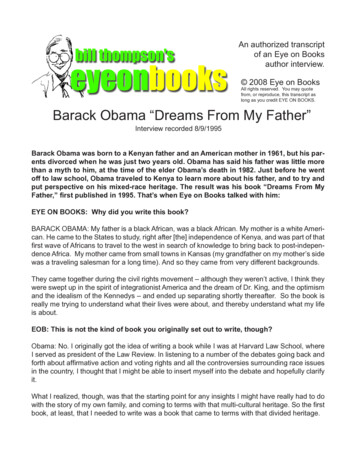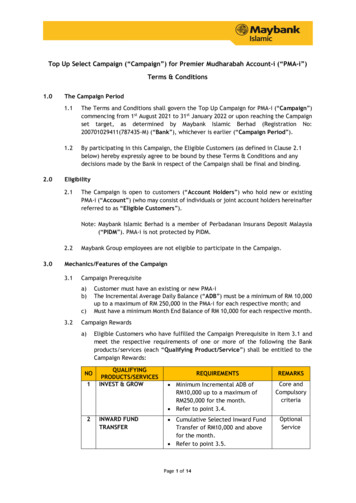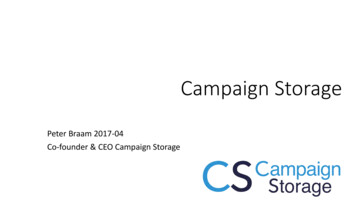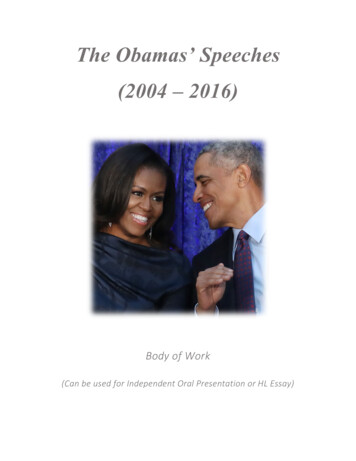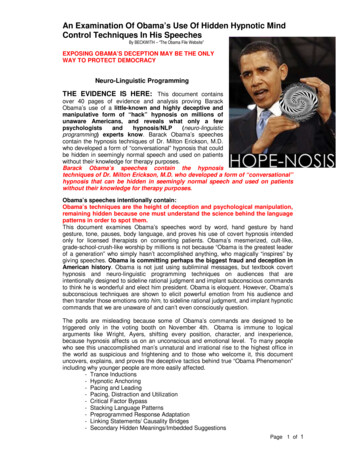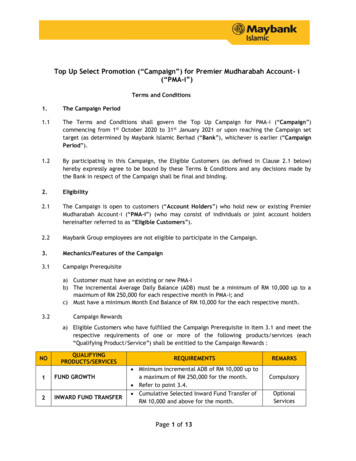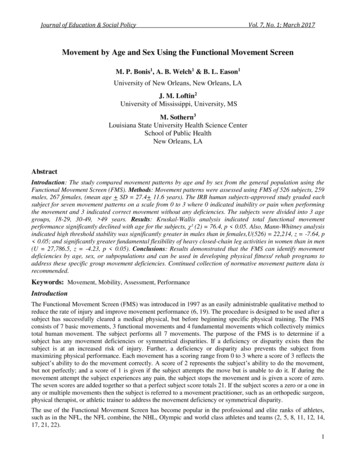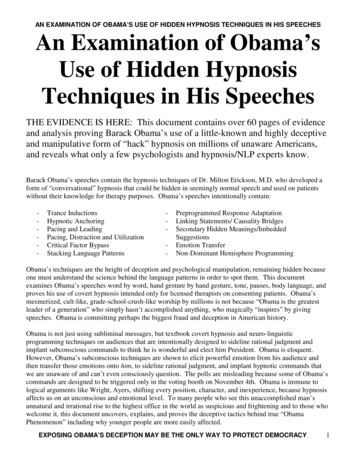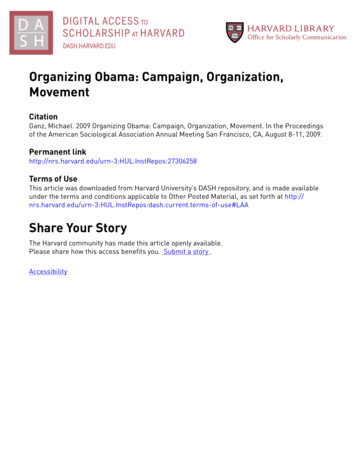
Transcription
Organizing Obama: Campaign, Organization,MovementCitationGanz, Michael. 2009 Organizing Obama: Campaign, Organization, Movement. In the Proceedingsof the American Sociological Association Annual Meeting San Francisco, CA, August 8-11, 2009.Permanent 06258Terms of UseThis article was downloaded from Harvard University’s DASH repository, and is made availableunder the terms and conditions applicable to Other Posted Material, as set forth at rrent.terms-of-use#LAAShare Your StoryThe Harvard community has made this article openly available.Please share how this access benefits you. Submit a story .Accessibility
Organizing Obama:Campaign, Organizing, MovementMarshall GanzHarvard Kennedy SchoolHarvard UniversityPrepared for American Sociological Association Annual MeetingSan Francisco, August 2009*** DRAFT COPY ONLY ***NOT FOR DISTRIBUTION WITHOUT PERMISSION OF THE AUTHORAll communications should be sent to Marshall Ganz, Hauser Center 238, Harvard Kennedy School,Harvard University, Cambridge, MA 02138, marshall ganz@harvard.edu
Remember!!! When Barack Obama announced his candidacy in January 2007, few ―experts‖ gave ita chance. Yet few campaigns ever finished on such a high note as the Obama campaign last November.As one Pennsylvania activist put it just 10 days after the election:―Delaware County PA volunteers have a fierce case of "Well, we're all fired up now, and twiddlingour thumbs!‖ I suspect it can't only be happening here, but all over the country. Here, ALL theleader volunteers are getting bombarded by calls from volunteers essentially asking"Nowwhatnowwhatnowwhat?"Over the course of the previous two years, a movement took shape within a political campaign, the―movement to elect Barack Obama.‖ Like earlier movements, it was rooted in shared values (equality,hope, community in diversity), driven by the creative energy of young people, demanded personal andpolitical change (racial attitudes, acceptance of civic responsibility, etc.), focused on a clear strategicobjective (electing Obama) and grew faster – and deeper - than anyone imagined. Because organizingwas at its core it generated far more than a list of donors, potential donors, and a network of electedofficials, funders, and campaign operatives: it trained some 3000 full time organizers, most of them intheir 20‘s; it organized thousands of local leadership teams (1100 in Ohio alone); and it engaged some1.5 million people in coordinated volunteer activity. And because this national campaign built its ownlocal organization – and eschewed the usual goulash of interest groups, party organizations, contractors,and 527‘s – it was able to develop a new political culture, a foundation for a genuine renewal ofAmerican politics.The purpose of this paper is to consider the role that organizing played by examining its part inturning an electoral campaign into a movement – or in harnessing a movement to turn it into an electoralcampaign. Many factors contribute to a campaign as successful as the Obama campaign - fund raising,paid media, earned media, scheduling, targeting, luck, etc. But by investing in an organizing programthe Obama campaign departed sharply from what had become the conventional way to run campaigns:marketing. This was a wise choice because for the insurgent Obama candidacy a conventional approachcould only have strengthened the hand of the candidate with more conventional resources – hisopponent.i. How did the decision to organize come about, what did it contribute, and what lessons canwe learn from this campaign that put organizing back on the map (with a little help from Rudy Giulianiand Sarah Palin, to be sure)Organizing, Movements, and LeadersAfter visiting the United States in 1831, Alexis de Tocqueville wrote: ―in a democracy,knowledge of how to combine is the mother of all forms of knowledge: on it depends all others.‖iiAttending to the role of political parties, churches, and civic groups he argued association could drawpeople out of a narrow individualism he feared into construction of those common interests required fordemocracy to work. Moreover, the fact these associations were voluntary meant they could be a sourceof renewal of civic values on which a healthy polity depends. And finally, although perhaps of lessconcern to de Tocqueville, the democratic promise is that the combination of equal voices can, to someextent, balance domination by those with greater resources. Making democracy work, in other words,requires not only the protection of individual liberties, but also the creation of collective capacity. Thisis what organizers do.Unlike political ―marketers‖ who sell causes, candidates, or commodities by appealing to thepreferences of their customers; unlike philanthropic ―providers‖ who dispense services to needy clients;and unlike social ―entrepreneurs‖ who devise technical solutions to challenging public problems;
organizers identify, recruit and develop leaders who can mobilize constituents to ―stand together‖ tolearn, collaborate, and act on behalf of common purposes. iiiOrganizing has driven the great social movements that since our founding have been ongoing, ifepisodic, sources of accountability, renewal and change.iv Social movements require organizing, but notall organizing yields a movement. But movements do emerge from the efforts of purposeful actors(individuals, organizations) to assert new public values, form relationships rooted in those values, andmobilize political, economic, and cultural power to translate these values into action.v They differ fromfashions, styles, or fads in that they are collective, strategic and organized.vi They differ from interestgroups in that they not only reallocate ―goods‖ but also redefine them. Not content with winning thegame, they try to change the rules.vii Initiated in hopeful response to conditions adherents deem ―unjust‖,movement participants make moral claims based on renewed personal identities, collective identities,and public action.viiiBecause social movements are dynamic, participatory, and organized to celebrate collectiveidentity and assert public voice, their structures of participation, decision making, and accountability areoften more like those civic associations that celebrate collective identity (churches, for example) orassert public voice (advocacy groups) than of those that produce goods or services. ix Participation restson moral suasion more than on economic or political coercion – or incentives – so the outputs depend onvoluntary, motivated, and committed participation of members and supporters.x Their authority structureis thus based more on leadership that can motivate commitment than exert control. xiOrganizers exercise and develop leadership - accepting responsibility to enable others to achieveshared purpose in the face of uncertainty. The need for leadership (a need often not met) is evident whenencounters with the uncertain demand adaptive response: past practices are breached, new threats loom;a sudden opportunity appears, social conditions change, new technology changes the rules, etc.xiiThe role of leadership in movements goes beyond that of the stereotypical charismatic publicpersona with whom they are often identified. Movements organize by identifying, recruiting anddeveloping leadership at all levels. Sometimes those who do this work, especially when they work at itfull time, are called organizers or, more colorfully in the past, lecturers, agents, travelers, circuit riders,representatives or field secretaries. Their focus, however, is on the development of volunteer leaders,rooted in communities they are trying to organize and on whom the vitality of the movement rests. TheGrange, for example, a rural organization key to the agrarian movement of the late 19th century, enjoyeda membership of 450,000 organized in 450 chapters, a structure that required recruiting men and womenfor 77,775 voluntary leadership posts, of which 77, 248 (99.3%) were local, 510 at the state level, andonly 17 at the national level. One out of every 5 members occupied a formal leadership post. Morerecently, a mainstay of the Conservative movement, the 4 million member NRA, rooted its activities in14,000 local clubs, governed by some 140,000 local leaders, one out of every 25 members.xiii The SierraClub, a 750,000 member environmental advocacy organization with some 380 local Groups organized in62 Chapters, must recruit, train and support volunteers for some 12,500 leadership posts, of which10,000 are local, 1 out of every 57 members.xivAfter 40 years during which conservatives seized the initiative by organizing a movement fueledby the race, gender, generation, and class reaction to the freedom movements of the 1960s, progressivesseem to find a way to reconnect themselves to a tradition that embraces change, diversity and equality.In this paper, I explain how organizing came to play such a prominent role in the Obama campaign, whyit happened, and suggest implications this may have for what will happen in the future.***
Creating the ConditionsFrom the outset, the campaign operated with certain ―givens‖, conditions without which it‘s hard toimagine a movement, or even a successful campaign, could have occurred: a motivating story of hope, astrategy that required a field campaign, and leaders who could do – and teach others how to do - theorganizing.Story of Hope:Narrative, Values and ConstituencyWhen Obama introduced himself to the nation at the Democratic National Convention in August,2004, he inspired a nationwide constituency by telling a story of his own calling, reminding us of ourcalling as a people, confronted us with urgent challenges to that calling, and inspired us to make choiceswe must make to realize our vision of who we are: a story of hope, a ―public narrative.xvRecognizingthat many Americans sensed a moral crisis in the land, not only a political one, his mastery of publicnarrative energized his audience around core values that had laid dormant among Democrats for years:equality, community, interdependence, and dignity. It was not that other political leaders did not sharethese values; but they seemed curiously unable to bring them alive in ways that could animate aconstituency. Eschewing policy rhetoric, Obama reached back to recount the courageous, hopeful, andloving choices of those who formed him, parents and grandparents, to inspire us with a story of where hewas going. He then reached back to the choices Americans made as country, our story, beginning withthe Declaration of Independence, bringing to life a sense of connection for which many longed (we arenot red states, not blue states, but a united states). To challenge us, he avoided a recitation of statistics,instead telling stories of individual people paying the price of our failure to live up to our values (aMaytag worker who lost health insurance, an inner city student with grades, but not the money, to go tocollege, etc.). And he called us to act, but with the hope that such action could succeed. Unlike mostDemocratic candidates who focus on the ―means‖ of public action – policies or programs among whichwe may choose - Obama focused on the ―ends‖ of public action – values that can inspire the action tofight for desired policy. More than anything else, this talk he called ―Audacity of Hope‖, he inspired asense of the possible, reaching beyond the probable, underscored by the anomaly of his ―very presence‖on the stage, a fact noted in his very first words. Obama‘s gift – and skill – for telling this story of hopecreated the potential for a movement especially among the young, a movement of ―moral reform‖ in thebest American tradition. But it could not happen if it were not organized.Field StrategyOrganizers on the GroundThis ―story‖ was to be enacted with a strategy that required mobilizing voters ―on the ground.‖ Towin caucuses, especially in Iowa, the first one, and in Nevada, and to win highly competitive primariesin New Hampshire and South Carolina, any campaign would have to have field staff on the ground. Butwhat they would do there was another question. In recent years, recognition that personal voter contactat the door is more effective than a call, a piece of mail, or a commercial, where this kind of contact isneeded, operatives usually hire – or contract for - a small army of paid canvassers, backed by a paidphone bank, to identify voters, persuade the undecided, and turn out the supporters on election day. xviViewed as ―flaky‖, difficult to control, and easily ―off message‖, volunteers play little or no role. In thisway the ―work‖ can get done, even on behalf of the least motivational of candidates, as long as it can bepaid for.A caucus is a different story. In 2004, observers noted that the Internet based fund raising success ofHoward Dean had not translated into success in Iowa, where it had been combined with a paid canvass.
The Kerry campaign, on the other hand, showed how caucus goers could be ―organized‖ - not by Deanstyle ―orange hats‖ dropped into the state at the last minute - but by locally based organizers who couldform relationships with each caucus attendee, identify leaders among them, and prepare them for all themaneuvering, negotiating, and decision making that goes on in a caucus. A top campaign priority, then,was to put organizers – not canvassers - on the ground in Iowa. It‘s proximity to Illinois, Obama‘s homestate, also promised a rich source of volunteer organizers, a stimulus to the Chicago Camp Obama thattrained them. Iowa was the focus of three experienced Midwestern campaigners: Steve Hildebrand,―early states‖ coordinator; Paul Tewes, Iowa director, Hildebrand‘s partner, and veteran of the 1999Gore Iowa effort; and Mitch Stewart, caucus director, and veteran of John Edwards 2003 Iowa work.And although caucuses had never been held in Nevada before, organizers were deployed there as wellbut due to the smaller size and later election date, in lesser numbers. A veteran of the 2004 Kerry workin Iowa, however, Mike Moffo, became field director.Although primaries require a much broader voter mobilization effort, the New Hampshire and SouthCarolina contests, due to their size and competitiveness, also required an ―on the ground‖ capacity toidentify and turn out voters on Election Day. Matt Rodriguez, director, and Rob Hill, field director,were both deployed early in 2007, and although experienced campaign operatives, they had little or noexperience in organizing. Although Hill had some experience with the Iowa caucus, much of his trainingwas as a paid canvasser for PIRG. So even though the primary was a year away, they deployed theirorganizing staffs as a voter ID ―army‖, calling and canvassing voters repeatedly for many months. Thiswas ironic because the one state in which the 2004 Dean campaign built a real organization was NewHampshire. It later became ―Dean for America‖ and played a key role in turning that ―red‖ state, ―blue.‖One of two deputy directors of the New Hampshire Dean campaign, however, Jeremy Bird, washired as field director for South Carolina. Bird, an aspiring organizer, had been hired by New Hampshirecampaign manager, Karen Hicks, and trained in community organizing in that electoral context. Hickshad rejected the canvass approach, turned her canvassers into organizers, and provided them training bythe author in the basics: story telling, one on one meetings, house meetings, strategizing, leadershipdevelopment, etc. The 2004 New Hampshire Dean campaign was one of the first opportunities a―critical mass‖ of young activists had to learn social movement organizing methods, as applied to anelectoral context. Besides Bird, Buffy Wicks (see below) came from this experience, as did ―star‖Clinton organizer, Roby Mook.Because he was allocated fewer staff than New Hampshire, since his election was later, but mostlybecause of his experience leading the NH Dean campaign, Bird from the beginning turned his staff intoorganizers, trained them in NH organizing methods, and, despite considerable pressure from Chicago for―making his daily voter id numbers,‖ began to develop the local leadership that would ultimately leadthat state to an overwhelming victory.Until July 2007, then, these were the states in which the campaign had deployed staff to conductfield programs. Across the country, however, a database of people wanting to volunteer grew daily andnew media ―MYBO‖ groups proliferated rapidly, but without any real strategic direction. In Chicago,the national field director, Temo Figueroa, was not responsible for the four ―early states‖, Hildebrand‘sbailiwick. He was to oversee the rest of the country, however, assisted by 4 ―desks‖, each of who had achunk of the country. Buffy Wicks, the ―desk‖ in charge of the 14 western states, was also a veteran ofthe 2004 Dean campaign, and a close associate of Bird‘s. Equally focused on organizing – especiallymotivated by the fact that so many people wanted to volunteer, but little was being done to engage them– Wicks had initiated a national canvass day that was viewed as a surprising success. By July, however,pressure was mounting on the national campaign, not only from would be volunteers, but from fundersfor results (?). In California, for example, where the deliberate work of developing leadership had, bydesign, not yet yielded voter ID numbers, these influential Obama supporters did not see anythinghappening on the ground. In response Figueroa decided to take Camp Obama ―on the road‖, using themto offer training to volunteers who would then be equipped with some understanding of what to do with
their desire to elect Obama. The first of these ―new‖ Camp Obama‘s was to be in California and Wickswas assigned to make it happen. Figueroa also asked the author to help, who, in turn, put together a teamof experienced trainers to support this training effort.Wicks organized two Camp Obama‘s in Los Angeles and San Francisco, and in just two weeks,launching 200 volunteer leadership teams, coordinated by 4 organizers. These Camp Obama‘s differedfrom the Chicago version that had happened earlier in the campaign. They went beyond the individualtechnical training that had been the focus of those earlier efforts. Instead the 2.5 day session was used tostructure individuals into clearly defined leadership teams, trained in organizing skills (story telling,relationship building, strategizing, and action), and launched committed to strategic goals. In animportant act of confidence, the campaign gave them access to the coveted voter file, a database withextensive information on voters whom they would need to contact to meet their goals. Their work wouldalso be transparent, allowing for accountability, learning, and recognition. Wicks later built on thisapproach by developing an internet tool that allowed volunteers to work targeted list from their homes, atool that would morph into the ―neighbor to neighbor‖ tool used widely in the general election.Although three more ―on the road‖ Camp Obama‘s were held in St. Louis, New York, and Atlanta,only the Atlanta one took the same approach as California. This Atlanta effort was significant becausethe participation of the South Carolina field staff, who had implemented an organizing strategy with somuch success in that early primary, acquainted the Camp Obama training team with some of the newermethods, like the leadership team structure. Wicks conducted Camp Obama‘s on that model in a numberof her western states, equipping volunteers with basic skills and a leadership structure through whichthey could begin to work. Furthermore, videos of the California Camp Obama‘s were posted on youtube and i-store by a volunteer videographer, making them available to others as a training resource.Before long, Jon Carson, who had served a Illinois field director and had initiated the Chicago CampObama, was assigned to coordinate the February 5th states, both caucuses and primaries, where one ortwo organizers, a number of whom had been trained in California, were sent to initiate their ownorganizing efforts.Thus, from these early commitments of resources towards an organizing campaign model and theirresulting success, it was clear that field staff would have an unusually significant role to play in thiscampaign. This was not, however, for ―ideological‖ reasons, but because winning would require it. Norwas it clear what the balance would be between New Hampshire style canvassing, Iowa caucusorganizing, South Carolina primary election organizing, and California leadership team organizing.LeadershipRecruiting, Training, and DevelopmentAlthough with far more access to creative practitioners of the ―new media‖ than any other campaign,it was clear that the Obama campaign would not have a ―new media strategy‖ and an ―old organizing‖strategy, but, rather, an organizing strategy that incorporated new media tools.xvii Even while pioneeringnew media outreach via its MYBO groups, it was a campaign ―given‖ that a successful field programrequired disciplined leadership on the ground. Results of voter contact were counted, analyzed, andevaluated daily which made clear the critical role of accountability was critical from the beginning. Thisresults oriented organizing effort required disciplined field operatives.This focus on volunteer organizing would also mean that to achieve scale, especially as thecampaign grew, it would have to commit to ongoing leadership development. Although initial hiring tofill field positions drew on the ranks of experienced political operatives, most of those attracted toObama were quite young. Their energy was funneled into summer internships, organizing fellowshipsand similar efforts at developing leadership from this youthful fount. The rapid diffusion of staff fromIowa, New Hampshire, South Carolina, and Nevada early in 2008 created opportunities for fieldorganizers to become regional coordinators, for coordinators to become directions and for volunteers to
become organizers. And although expertise in intentional staff training came later in the campaign, thecampaign structure created opportunities for novices to learn, apprentices to develop, journeymen toflourish, and masters to teach. The very long primary season and the number of caucuses that requiredorganizing meant that the campaign had to build its own organizing capacity on a large scale. Thisnecessity created an enormous opportunity for leadership development. Suddenly you were in charge ofhalf a state!On the other hand, although daily accountability was expected from the national level, very littlementoring was available. And until the late spring of 2008, nothing approaching a national trainingprogram existed. As a consequence each of the four early states – with the possible exception of Nevada- developed its own ―organizing culture‖, grounding relationships that persisted for the entire campaign,creating patterns of promotion embedded within those relationships, and an almost tribal dimension thatwould follow staff disseminated across the states. If you wanted to know what someone‘s views onorganizing – or how to treat volunteers – all you had to ask was which state they were from.It was very clear that spontaneous ―self-organization‖, the wished for result of online organizers, is amyth. On the contrary, developing a motivated, skilled, and strategic volunteer effort required ongoingcoaching of organizers who, in turn, could provide coaching to volunteer leaders, creating a virtuouscycle of increased capacity. This required an ongoing investment in training and coaching that couldcascade down through the campaign as those who learned these skills were called upon to teach them toothers.Five Organizing PracticesNarrative, Relationship, Structure, Strategy, ActionAs the election results began to come in, early in 2008, organizing approaches taken in SouthCarolina and Iowa, as well as the volunteer work that came out of California, began to carry the day.The regime of measurement, accountability, and analysis of results established at the national level earlyon meant that novel approaches could be seen. The criteria was simple: whatever works, works. At Mayand June meetings in Chicago, the field leadership was convened to look at the results, consider whathad been learned, and develop a common organizing approach for the general election, beginning withthe training of some 3000 summer ―organizing fellows.‖ As Hildebrand had become deputy campaignmanager, Figueroa reassigned to focus on the Latino vote, Carson became field director, presiding overthis process. Essentially, it was a negotiation among approaches; Iowa and South Carolina, the mostrelevant, and the results codified in an organizing fellow field manual. Even so, what played out in anygiven place – and the understanding and energy with which it was implemented – remained a function of―tribal‖ affiliation. The following are features of the approach that although not implemented universallywas close to a campaign ―standard‖, distinguishing it from any that preceded it as a blend of organizing,movement building, and electoral success.Organizing rooted in bringing people together around shared values, the work of public narrative.Values based organizing, unlike issue based organizing, invites people to escape ―issue silos‖ and cometogether as complete human beings whose diversity can becomes an asset for, rather than an obstacle tocollective effort. Because values are experienced – and communicated - emotionally, they are the sourceof the moral energy – courage, hope, and solidarity - that it takes to risk learning new things, exploringnew ways. And because values that inspire action are communicated as narrative, each person can learnto inspire others by learning to tell their own story, a story of the experience they share with others, anda story of an urgent challenge that demands action – a public narrative.
Public narrative is a leadership practice. Through narrative we learn to make choices in response tochallenges of an uncertain world – as individuals, as communities, as nations. To respond to urgentchallenge creatively, we draw on sources of hope over fear; empathy over alienation; and self-worthover self-doubt – matters of the heart we can learn to articulate as our story. We must also formulate avision how we can act, a matter of the head, articulated as our strategy. And then, of course, we mustact, a matter of developing skillful and determined hands. Public narrative can help us link our owncalling to that of our community to a call to action now – a story of self, a story of us, and a story ofnow.xviiiAs a practice, it can be structured, learned, and shared. The training offered by the Obama campaign wasnot built around learning Obama‘s story, but, rather, learning to articulate one‘s own story – not simplyas a form of ―self-expression‖ but, rather, as a way to engage others, at a deep level, in participating inthe campaign. Focus on mastering the craft of story telling permeated the campaign through you-tube,campaign websites, and, perhaps most dramatically, Obama‘s ―race‖ speech, delivered in Philadelphiaon xxx which concluded with the ―story‖ of Ashley, as had occurred in a South Carolina house meeting.Learning the practice of public narrative enabled organizers and volunteers to articulate the core valuesof the campaign, encouraged trust among them, and enhanced their efficacy by enabling them to engagevoters far more effectively than the use of traditional scripts, talking points, or messaging.Organizing based on relationships based on mutual commitments to work together on behalf ofcommon interests.It is the process of association – not simply aggregation - that makes a whole greater than the sum of itsparts. As de Tocqueville noted, through association we can learn to reinterpret our individual interests ascommon interests, an objective on behalf of which we can use our combined resources. Relationshipbuilding thus goes beyond delivering a message, extracting a contribution, or soliciting a vote. These―lateral‖ connections, entirely missed in canvassing, telemarketing, or most email driven operations, arewhat create the ―glue‖ – or social capital - that sustains volunteer engagement in the face of challenge,inspires creativity in the work, and supports reaching out to diverse social networks to engage thebroader community. xixCampaign organizers learned the craft of the one on one meetings and the house meetings that laid thefoundation for local organization, rooted in the commitments people made to each other, not simply anidea, task, or issue. One on one meetings are held to initiate an ongoing working relationship, not simplyget a signature, a donation, or a pledge of support xx - a key distinction between organizing andmobilizing. Successful one on one meetings can lead to a house meeting to which the ―host‖ invites abroad network of associates to attend – some of whom agree to hold their own meetings, thus activatingthe networks that weave their way through every community. It was the house meeting approach thathad been so successful in the 2003 Dean New Hampshire campaign and which became the model for thebest organizing in the Obama effort. One advantage this approach for an ―insurgent‖ candidacy is that itis a way to identify community leaders by testing them – those successful in hosting a meetingdemonstrate potential – a way to avoid depending on established organizations that may resist change, orare allied with one‘s opponent.In the South Carolina campaign, for example, by October 2007, organizers had held some 400 housemeetings, attended by some 4000 people, the foundation for a mobilization that would deploy 15,000Election Day volunteers, most of them active politically for the first time.xxi
Organi
campaign. Many factors contribute to a campaign as successful as the Obama campaign - fund raising, paid media, earned media, scheduling, targeting, luck, etc. But by investing in an organizing program the Obama campaign departed sharply from what had become the conventional way to run campaigns: marketing.
